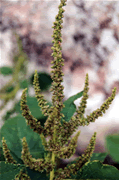
Tanduliya

Common Names
About  Taxonomy
Taxonomy
 to access the GRIN database record about the specific taxonomical hierarchy (Family, Genus etc.).
to access the GRIN database record about the specific taxonomical hierarchy (Family, Genus etc.).CLASSIFICATION
ALTERNATE FAMILY
OTHER FAMILY:
SPECIES
Plant Description
Annual herb, erect or slightly decumbent, simple or much-branched and bushy, up to 1.5 m in height. Stem stout, sometimes reddish, usually branched, angular, glabrous or increasingly furnished above (especially in the inflore¬scence) with long, multicellular, flocculent hairs. Leaves glabrous, or thinly pilose on the lower surface of the primary nervation, long-petiolate (petioles up to c. 9 cm, sometimes longer than the lamina), the lamina ovate to rhomboid-ovate, elliptic, lanceolate-oblong or lanceolate, c. 1.5-12 x 0.8-6 cm, subacute or more commonly blunt or retuse at the tip with a distinct, fine, colourless mucro, cuneate or attenuate at the base; each leaf-axil bearing a pair of fine and slender to stout and compressed spines up to c. 2.5 cm long. Flowers green, in the lower part of the plant in axillary clusters 6-15 mm in diameter; towards the ends of the stem and branches the clusters are leafless and approximated to form simple or sometimes (especially the terminal) branched spikes usually up to c. 15 cm long and 1 cm wide. Lower clusters entirely female, as are the lower flowers of the spikes; upper flowers of the spikes male, mostly for the apical 1/4-2/3 of each spike. Bracts and bracteoles deltoid-ovate, pale-membranous, with an erect, pale or reddish awn formed by the excurrent green midrib; bracteoles shorter than, subequalling or little exceeding the perianth, commonly smaller than the bracts. Perianth segments 5, those of the female flowers c. 1.5-2.5 mm, narrowly oblong or spathulate-oblong, obtuse or acute, mucronulate, frequently with a greenish dorsal vitta; those of the male flowers broadly lanceolate or lanceolate-oblong, acute or acuminate, only the midrib green. Stigmas (2-) 3, flexuose or reflexed, 1-1.5 mm. Capsule ovoid-urceolate with a short inflated neck below the style base, c. 1.5 mm, regularly or irregularly circumscissile or rarely indehiscent, the lid rugulose below the neck. Seed 0.75-1 mm, compressed, black, shining, very faintly reticulate.



 Your current navigation map.
Your current navigation map.